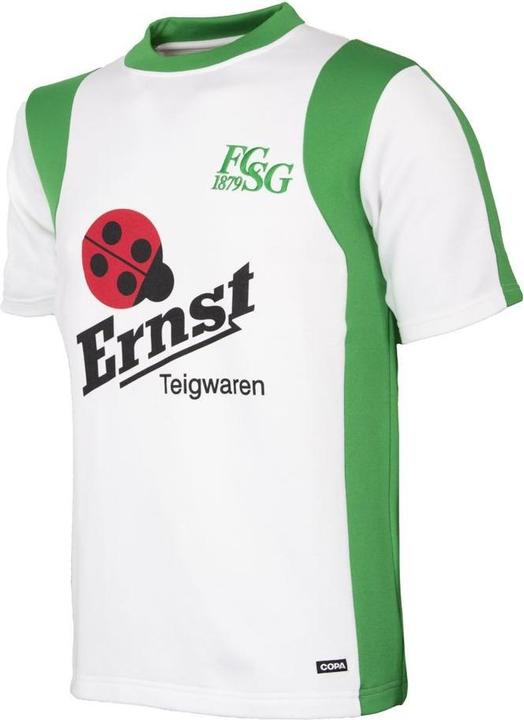
Copa Football FC St. Gallen 1978 - 80 Retro Shirt | FC St. Gallen 1978 - 80 Vintage Shirt
XL

There’s a wave sweeping the world right now. Not a Mexican one – a fashion one. Football club jerseys from the 80s or 90s have recently become top sellers. And the clubs are cashing in on the trend, too.
Do you know which company was advertised on the FC St. Gallen jerseys in 1978? No? Well, I’ll tell you: it was Ernst Teigwaren. Until the 1970s, such a thing was unthinkable. Associations and clubs agreed that advertising would damage the «amateur, community-oriented nature of the game». Opinions had to change before companies were able to print their lettering across the chest of a jersey. Sports sponsorship became a new field in marketing, and instead of global corporations, it was often local companies that initially supported «their» football club.
Today, football is a billion-dollar business. Clubs, players, consultants, media and sponsors – everyone wants to earn big money. A good source for it? The fans. Young boys wear Messi, Ronaldo, Yamal or Mbappé shirts. Dads wear their favourite club’s current jersey to the stadium, sometimes with their own name above the number. And female fans? They’ve also discovered football jerseys – as a stylish item of clothing, as a change from a blouse or designer shirt. Or there are some who merge the two and prefer a shirt like the one from Venezia FC. Football meets fashion, so to speak.
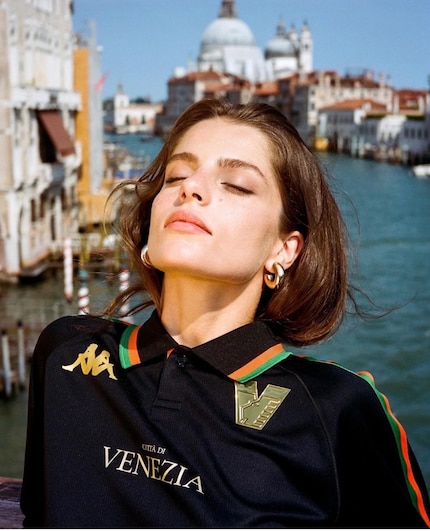
The trend even has a name: Blokecore. Under the corresponding hashtag, you’ll find hundreds of thousands of photos on social media of women in 90s jerseys. Editorial colleague and fashion expert Laura has written more about it here:
The vintage jerseys are easily tucked into trousers or skirts by fashion-conscious wearers. They wear a jersey with the colour that suits best. That’s how much range there is. One day it’s the blue and black of Inter Milan, the next black and red for AC Milan – what works in fashion is sacrilege for fans.
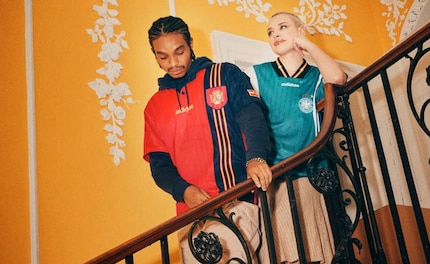
The sporting goods giants have also jumped on board the retro hype. Adidas, Nike and co. are no longer just staging retro as fan nostalgia, but as a tangible sales strategy. For the 2023/24 season, Adidas sent several top clubs into the Champions League with retro-inspired special edition jerseys. Bayern, Arsenal, Juve, Manchester United and Real Madrid appeared in shirts with the old Trefoil logo and classic club crests – marketed as a «real fashion statement».
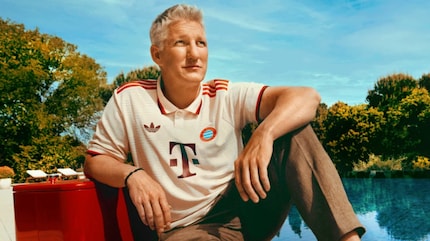
And the collections were, in fact, well received. Tracksuits and shirts in the 90s look sold brilliantly around the 2024 European Championships. Adidas CEO Bjørn Gulden even spoke of the initial gains that the strategy was yielding financially (article in German). The quarter saw an 11-per-cent increase in turnover, resulting in an upward annual projection.
Nike also joined in on the retro references: Liverpool wore a home shirt last season that was strongly reminiscent of the 1984 design – the year they won the national cup. And for its 125th anniversary, AC Milan even showed how broadly nostalgia can really be staged: together with Puma, New Era, Off-White and even the New York Yankees, it dropped several lifestyle collections. The players even wore some pieces in official matches.
Retro as an anniversary statement, mid competition.
And it’s not just the big clubs riding the nostalgia wave. The German national team played two international matches in retro jerseys this spring, and they can still be seen in the World Cup qualifiers. The reason for the jerseys being the 125th anniversary of the football association. Outfitter Adidas made a big marketing splash, including an elaborate advertisement.
Even a club like 1. FC Nuremberg, once victorious, now languishing in the second Bundesliga, is going retro. A special jersey for the 125th anniversary of the club brought the online store’s servers to their knees (article in German). FC Augsburg has joined in with pseudo-retro chic and sells a «Roman» jersey (page in German). Super League club FC St. Gallen has retro shirts from different eras – one with sponsor Fido on the chest, the other with Ernst Teigwaren – just like almost 50 years ago.

Copa Football FC St. Gallen 1978 - 80 Retro Shirt | FC St. Gallen 1978 - 80 Vintage Shirt
XL
Perhaps it’s partly the logos of long-defunct companies that make retro jerseys so appealing. Why not advertise dog food with «Fido» on your chest? Or how about «Commodore» on FC Bayern’s kit from the 1980s, or an SSC Napoli shirt with «Buitoni» on it from the Maradona era? Wasn’t everything better in those days anyway? Airlines from autocratic Arab emirates or global tech companies advertise themselves on today’s jerseys. This isn’t something everyone can identify with.
If you want to re-produce an old jersey, you first have to go through a minefield of legal rights. Logos, crests and club colours belong to the clubs, not nostalgia manufacturers. Brands such as Copa Football therefore secure official licenses. If possible, also those of the official jersey sponsor. For example, Buitoni or Motta in the case of Napoli or Milan. This allows them to use the historic designs – and in return, money flows back to the clubs and their sponsors.
The result is retro jerseys that are officially approved. No illegal copies, but merchandise with permission. Copa is the official retro partner of Barcelona, Milan, Bayern and Juventus. For fans, this means that they can wear a piece of club history without being in the grey area.
The question of who can profit from the retro trend is an exciting one. Of course, big suppliers like Adidas, Nike and Puma have the rights to the current jerseys and pay record sums in the billions for them. But the retro scene doesn’t automatically fall under these contracts. Some clubs have deliberately launched their own collections on the market in recent years without involving their official supplier (article in German). More margin for the club, less for Adidas and the like.
However, there’s still an element of risk involved. After all, logos and trademarks such as the famous three stripes belong to the manufacturers. Anyone who uses them without permission will soon end up in court. That’s why many retro jerseys lack the original manufacturer logos. The legendary Bayern shirt from the 80s is available from Copa with the club crest and sponsor – but without the Adidas lettering. Retro, yes. But legal.
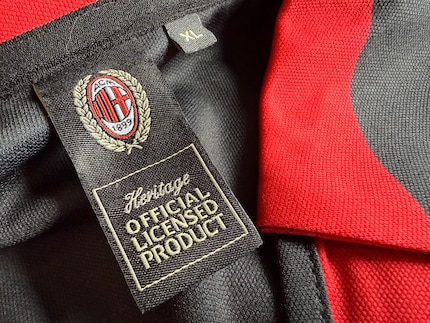
There are also specialised dealers who offer original goods. In other words, jerseys that were actually produced many years, sometimes decades ago. Leon Rademaker is the founder and operator of the online store «Trikotstoff». You won’t find jerseys there that merely imitate the earlier originals, you’ll find the «real deal».
Leon explains that with vintage jerseys like these, nobody has to worry that the fabric has suffered over the years. The quality back then was no worse than it is today. The flocks, i.e. the player names or sponsor logos applied to the fabric, sometimes show signs of wear. In an interview with Galaxus, Leon explained:
If you treat the jerseys normally and wash them gently, even jerseys that are over 20 years old can still look very good.
Thanks to his many years of experience, Leon knows exactly which jerseys are in demand and when. Certain events such as the 2024 European Championships have a noticeable impact. The seller recalled how the jerseys from German, Austrian and Swiss national teams were literally snatched out of his hands back then. The rise of a traditional club such as HSV also causes a surge in demand.
Where are these jerseys from? Leon buys them from private individuals who are liquidating old collections, for example. In an interview with magazine Kicker, Rademaker once said that the sale wasn’t about maximising profits. «I don’t think it’s fair», says the football fan. That’s why his old jerseys usually cost well under 100 euros, less than the top clubs want from their fans for current models. Unlike the corporations and clubs, he’s unlikely to make lots of money from it; it’s more of a fan-to-fan service.

The retro boom shows how double-edged nostalgia can be. For Adidas, Nike and the big clubs, it’s a billion-dollar business in which retro jerseys bring leaps in sales and record contracts. For small dealers like Leon Rademaker, however, it remains a side hobby. A service to the fans instead of profit maximisation.
Maybe that’s exactly the appeal of the old shirts. Whether it was Ernst Teigwaren at FC St. Gallen, Fido for dog food or Commodore at FC Bayern, they’re reminiscent of a time when football wasn’t yet completely commercialised. «With Buitoni, you win titles,» was the saying at the time. These days it’s more like: «With Qatar Airways, you win markets.»
Sounds less romantic, but sells anyway.
Where do you wear the shirt of your favourite club? Let us know in the comments!
Journalist since 1997. Stopovers in Franconia (or the Franken region), Lake Constance, Obwalden, Nidwalden and Zurich. Father since 2014. Expert in editorial organisation and motivation. Focus on sustainability, home office tools, beautiful things for the home, creative toys and sports equipment.
Interesting facts about products, behind-the-scenes looks at manufacturers and deep-dives on interesting people.
Show all